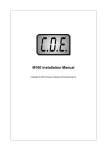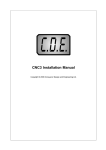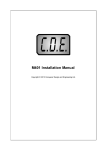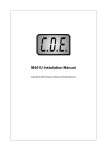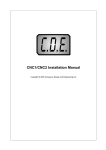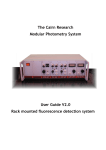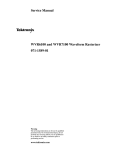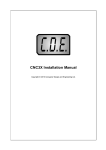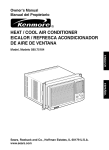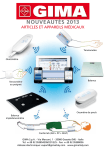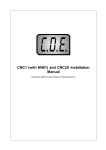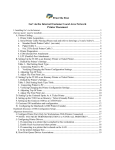Download M640/M641 Installation Manual - Conqueror Design & Engineering Ltd
Transcript
M640/M641 Installation Manual Copyright © 2007 Conqueror Design and Engineering Ltd. M640/M641 Installation Manual Copyright © 2007 Conqueror Design and Engineering Ltd. All rights reserved. Any dispute about the use of this software and/or hardware or of these terms and conditions shall be resolved or arbitrated under English Law. Manuals and accompanying documentation may not be copied or printed for the purposes of training, advertising, promotion or any other use without the permission of Conqueror Design and Engineering Limited. Permission to copy and print manuals and documentation for personal use is granted to the owner/user of the software supplied. All trademarks are acknowledged to be the property of their respective owners. This manual produced on 29/07/2007. Warranty This software and/or hardware and accompanying documentation are provided 'as-is' and are not warranted to be fit for any specific purpose or usage. The use of this software and/or hardware is undertaken at your own risk and Conqueror Design and Engineering Limited will not be responsible for any loss of data, time or income resulting from the use of this software and/or hardware. Contents I Table of Contents Part 1 Disclaimer of liability and limitation of warranty 1 Part 2 Introduction to the M640 card 2 1 Mounting ................................................................................................................................... details 3 2 Components ................................................................................................................................... of the card 4 3 RS232 ................................................................................................................................... serial interface 5 4 Connector ................................................................................................................................... for stepper motor drives 6 Optional opto-isolator ......................................................................................................................................................... card, OPTOCARD 8 Optional opto-isolator/relay ......................................................................................................................................................... card, OPTOCARD2 10 5 Connectors ................................................................................................................................... for jog-buttons, limit-switches, optical-encoders and the safety-circuit 13 6 Relay................................................................................................................................... driver connectors 14 7 Quadrature-encoders ................................................................................................................................... / closed-loop operation 16 Quadrature-encoders ......................................................................................................................................................... 17 Part 3 M641 card addendum 19 1 Changes ................................................................................................................................... to the layout/connectors 20 2 Adding ................................................................................................................................... the analogue output to an M640 card 22 Part 4 Encoder & photo-interrupter connections 23 1 GP1R11 ................................................................................................................................... quadrature-encoder 23 2 GP1A23 ................................................................................................................................... photo-interrupter 24 Part 5 Manual operation without a computer 25 Part 6 Direct control via the RS232 26 Part 7 Appendices 27 1 G-Codes ................................................................................................................................... 27 Additional G-codes ......................................................................................................................................................... for lathe operations 28 Additional G-codes ......................................................................................................................................................... for milling operations 29 2 M-codes ................................................................................................................................... 30 3 Command ................................................................................................................................... set 31 4 Control ................................................................................................................................... parameters 33 Copyright © 2007 Conqueror Design and Engineering Ltd. I II M640/M641 Installation Manual Index 38 Copyright © 2007 Conqueror Design and Engineering Ltd. Disclaimer of liability and limitation of warranty 1 1 Disclaimer of liability and limitation of warranty Where the M640/M641 is supplied as a component and not as part of a complete control system it is assumed that the purchaser has sufficient electrical and electronic knowledge to handle the component competently. It is further assumed that the purchaser has sufficient knowledge of safe working practices and the relevant Health & Safety regulations which apply to working with electrical and electronic systems to work safely with the component. Conqueror Design and Engineering Limited will not accept any liability for any damage to systems or personnel that may result from the incorrect installation or usage of the hardware supplied. Nor will Conqueror Design and Engineering Limited replace or repair any supplied equipment that has been damaged as a result of such incorrect misuse or installation. Copyright © 2007 Conqueror Design and Engineering Ltd. 2 2 M640/M641 Installation Manual Introduction to the M640 card The M640 card has been designed to control CNC lathes, milling machines, PCB drills, routers, etc. In fact any machine which has 1, 2, 3, 4, 5 or even 6 stepper motor driven axes. The stepper motors can also, optionally, be controlled in a closed-loop mode with the addition of standard quadrature encoders in either strip or rotary form. The card also provides for on/off control for an AC or DC spindle motor and common auxiliary equipment such as coolant pumps. A machine fitted with an M640 can be operated in a simplified stand-alone manual mode (for cleaning and maintenance, etc.) without requiring a host computer and, with the addition of an optional LCD and keypad, can also operate in a fully stand-alone mode similar to an industrial machine. A low-cost 2-channel encoder can be connected to the quadrature encoder connector QH to provide a hand-wheel for positioning the axes. The manual/stand-alone mode of the card is 'hand-wheel' ready. Copyright © 2007 Conqueror Design and Engineering Ltd. Introduction to the M640 card 2.1 Mounting details Copyright © 2007 Conqueror Design and Engineering Ltd. 3 4 2.2 M640/M641 Installation Manual Components of the card 1. 2. 3. 4. 5. 6. 7. 8. 9. 10. 11. Onboard processor for stand-alone operation. Second processor for closed-loop operation (quadrature encoders). Standard 9-pin RS232 for connection to a computer system. Connector for stepper motor drives (Enable, Clock and Direction signals). Connectors for discrete buttons for X+, X-, Y+, Y-, Z+, Z-, 9 limit switches, a control button, 2 optical encoder channels and a safety circuit. Spindle-motor-run relay drives - 2 12 volt 500 mA outputs. Spindle-motor-reverse relay drive (uses general purpose relay #2). Coolant-control relay driver. 2 general purpose relay drives. External power supply input (12-35 volts DC). Remotely upgradeable firmware (firmware is upgradeable from within the EaziCNC software). The card is supplied with EaziCNC editing and programming software for Microsoft Windows. Please refer to the separate EaziCNC manual for details on operating the EaziCNC software. Copyright © 2007 Conqueror Design and Engineering Ltd. Introduction to the M640 card 2.3 5 RS232 serial interface Pin Signal 2 Receive Data (RCD) 3 Transmit Data (TXD) 5 Ground The serial port is configured as a standard PC AT 9-pin port. A standard PC-AT to PC-AT serial cable (a cross-over cable) can be used. The default protocols are 115200 baud, 8 data bits, no parity and 1 stop bit (older cards may operate at either 19200 or 38400 baud until the firmware is updated). The board will use XON/XOFF flow controls by default. If you are making your own cable you should wire it as follows (if you use shielded cable connect the shield to the plug casing at the PC end only!)... Copyright © 2007 Conqueror Design and Engineering Ltd. PC M641 2 3 3 2 5 5 6 2.4 M640/M641 Installation Manual Connector for stepper motor drives Pin Function 1 VCC (+5-volts). 2 Ground (0-volts). 3 STPX. Clock/Step-pulse for X motor. 4 STPY. Clock/Step-pulse for Y motor. 5 STPZ. Clock/Step-pulse for Z motor. 6 STPE. Clock/Step-pulse for E/U motor. 7 DIR. Motor step direction. Shared by all drives. [or direction for X only if separate direction outputs are selected] 8 ENABLE. Used to idle the stepper motor drives when not in use. [or direction for Y only if separate direction outputs are selected] 9 STPV. Clock/Step-pulse for V motor. [or direction for Z only if separate direction outputs are selected] 10 STPW. Clock/Step-pulse for W motor. [or direction for E/U only if separate direction outputs are selected] Connector J2 at the bottom left of the M640 card is used to attach the separate stepper motor drive cards. If the stepper motor drive cards STEP1, STEP2, STEPHP1 or SERVO1 are used then the connections to the cards can be made via a straight ribbon cable "bus" and the cards can be configured to identify as X, Y, Z, E/U, V or W. If other drive cards are used then it will Copyright © 2007 Conqueror Design and Engineering Ltd. Introduction to the M640 card 7 probably be necessary to use a terminal block or Y-cables to connect the shared signals to the different cards. N.B. It is possible to select separate direction outputs for the X, Y, Z and E motors for use with motor control cards that require the direction signal to be held constant between step pulses. If this option is selected (see the control parameters section) then it is not possible to control the V and W motors or to make use of the auto-power-down function of the M640 card. The timing of the motor control signals from the M640 card is... Copyright © 2007 Conqueror Design and Engineering Ltd. 8 2.4.1 M640/M641 Installation Manual Optional opto-isolator card, OPTOCARD The opto-isolator card, OPTOCARD(R1), allows the external stepper drive card signals to be connected to drive cards which do not operate at 5-volt TTL signal levels. The card also splits the direction signal into 4 separate outputs to make it easier to connect drive cards which need individual directions signals. The card is suitable for interfacing to logic levels of 5-50 volts. Copyright © 2007 Conqueror Design and Engineering Ltd. Introduction to the M640 card 9 The J1 connector pin out is as follows... Pin Function 1 VCC (+5-volts). 2 Ground (0-volts). 3 STPX. Clock/Step-pulse for X motor. 4 STPY. Clock/Step-pulse for Y motor. 5 STPZ. Clock/Step-pulse for Z motor. 6 STPE. Clock/Step-pulse for E/U motor. 7 DIR. Motor step direction. Shared by all drives. 8 No connection. 9 No connection. 10 No connection. The J2 connector can be used to invert the signals going to the external cards. The standard signals are active-low. Connecting a shorting link across J2 will make the signals active-high. The board is supplied with a shorting link on connector J2. The J3, J4, J5 and J6 connectors are for connecting the external drive cards for the X, Y, Z and E/U motors respectively. The pin out of the connectors is (pin 1 is indicated by the square pad)... Pin Function 1 Step clock - 2 Step clock + 3 Direction + 4 Direction - ...each opto-isolator can shunt 25 mA. The opto-isolated outputs are only suitable for driving logic inputs. To connect to a standard logic interface the - (negative) terminal of the isolator will be connected to the ground (0v) rail of the logic system and the + (positive) terminal of the isolator will be connected to the logic signal. When the isolator is active current will flow from the + (positive) terminal to the - (negative) terminal. Copyright © 2007 Conqueror Design and Engineering Ltd. 10 2.4.2 M640/M641 Installation Manual Optional opto-isolator/relay card, OPTOCARD2 Copyright © 2007 Conqueror Design and Engineering Ltd. Introduction to the M640 card 11 The opto-isolator card, OPTOCARD2, allows the external stepper drive card signals to be connected to drive cards which do not operate at 5-volt TTL signal levels. The card also splits the direction signal into 4 separate outputs to make it easier to connect drive cards which need individual directions signals. The card is suitable for interfacing to logic levels of 5-50 volts. The OPTOCARD2 also includes power-relays for interfacing high-current loads to the M640/M641 and optically-isolated jog-panel and limit-switch connectors which can operate at 12-volts. The STEPBUS connector pin out is as follows... Pin Function 1 VCC (+5-volts). 2 Ground (0-volts). 3 STPX. Clock/Step-pulse for X motor. 4 STPY. Clock/Step-pulse for Y motor. 5 STPZ. Clock/Step-pulse for Z motor. 6 STPE. Clock/Step-pulse for E/U motor. 7 DIR. Motor step direction. Shared by all drives. 8 No connection. 9 No connection. 10 No connection. The XSTP, YSTP, ZSTP and USTP connectors are for connecting the external drive cards for the X, Y, Z and E/U motors respectively. The pin out of the connectors is (pin 1 is indicated by the square pad)... Pin Function 1 Step clock - 2 Step clock + 3 Direction + 4 Direction - ...each opto-isolator can shunt 25 mA. The opto-isolated outputs are only suitable for driving logic inputs or other opto-isolators. To connect to a standard logic interface the (negative) terminal of the isolator will be connected to the ground (0v) rail of the logic system and the + (positive) terminal of the isolator will be connected to the logic signal. When the isolator is active current will flow from the + (positive) terminal to the (negative) terminal. The XD/S, YD/S, ZD/S and UD/S jumpers select whether the direction outputs for each connector are from the shared direction signal or separate direction signals. Copyright © 2007 Conqueror Design and Engineering Ltd. 12 M640/M641 Installation Manual The X+X-, Y+Y-, Z+Z-, etc. connect to the input plugs on the X641 card. The BX+X-, BY+Y-, etc. are the 12-volt buffered connections for the buttons and switches on the machine. Copyright © 2007 Conqueror Design and Engineering Ltd. Introduction to the M640 card 2.5 13 Connectors for jog-buttons, limit-switches, optical-encoders and the safety-circuit The connectors for the jog-buttons, limit-switches, optical encoders and the safety circuit are located along the top edge of the board... In each case the square pad located inside each connector indicates pin1 (it is at the right of the connector in each case). FB1 and FB2 are the threading sensors - FB1 is the single-slot (1 count/rev) and FB2 is the multi-slot. X+, X-, Y+, Y-, Z+ and Z- axis jog-button, BN1 connectors, LIME, LIMV, LIMW Pin Function 1 Button signal. Short to pin 2 to activate button (i.e., connect the switch across the 2 pins) 2 Ground FB1 and FB2 optical-encoder connectors Pin Function 1 VCC (+5-volts). 2 Encoder signal. 3 Ground (0-volts). STP - safety-circuit connector Pin Function 1 Safety circuit +. 2 Safety circuit LIM1, LIM2, LIM3 and LIM4 limit-switch connectors Pin Function 1 Positive travel limit signal. Short to pin 2 to activate limit (i.e., connect the switch across the 2 pins) 2 Ground (0-volts). 3 Negative travel limit signal. Short to pin 4 to activate limit (i.e., connect the switch across the 2 pins) 4 Ground (0-volts). Copyright © 2007 Conqueror Design and Engineering Ltd. 14 2.6 M640/M641 Installation Manual Relay driver connectors The relay connectors are located along the right edge of the M640. In each case pin 1 is the square pin in the connector (In practice the polarity of the connections does not matter unless solid-state relays are used). Pin Function 1 + relay drive voltage. 2 - relay drive voltage. The onboard relay drives can drive relays requiring up to 500 mA but the combined current for all relays & fans should not exceed 1,250 mA. Relay Function REM1 To control the spindle motor run/stop. REM2 To control the spindle motor run/stop. REC To control the coolant pump if fitted. RE1 Auxiliary relay #1 Copyright © 2007 Conqueror Design and Engineering Ltd. Introduction to the M640 card RE2 Auxiliary relay #2. Also used if the spindle motor is reversed. FAN1 Always on... can drive cooling fans, work-lights, etc. FAN2 Always on... can drive cooling fans, work-lights, etc. 15 Any relays connected to the drivers should be fitted with suitable snubbers to protect the loads that they are driving. Copyright © 2007 Conqueror Design and Engineering Ltd. 16 2.7 M640/M641 Installation Manual Quadrature-encoders / closed-loop operation The card has connectors for 6 quadrature-encoders... for the axes X, Y, Z, E/U, V and W. Pin 1 in each case is the square pad. In most configurations the 6th encoder (QH) is used for an electronic hand-wheel for axis positioning. QH, QX, QY,QZ,QE/U and QV Quadrature Encoder connectors Pin Function 1 VCC (+5-volts). 2 Encoder channel A 3 Encoder channel B 4 Ground (0-volts). Copyright © 2007 Conqueror Design and Engineering Ltd. Introduction to the M640 card 2.7.1 17 Quadrature-encoders Quadrature-encoders output 2 pulse trains, A and B, which are out of phase. The 'quadrature' in the name is derived from the fact that there are 4 states for the 2 signals to be in... A-off-with-B-off, A-on-with-B-off, A-on-with-B-on and A-off-with-B-on. The sequence of these states determines the direction of rotation of the encoder (and the motor or shaft that it is attached too)... For feedback from the motors optical encoders are usually used... Copyright © 2007 Conqueror Design and Engineering Ltd. 18 M640/M641 Installation Manual ...because they place no load on the drive system and can cope with the high speeds that motors and shafts may turn at. The encoder pictured is a rotary encoder with a slotted disk... the disk determines the resolution of the encoder... in this case 400 counts/rev. Optical encoders also come in strip or linear forms and there are other types of non-contact encoders that can be used (such as capacitance strips or magnetic proximity switches). For the hand wheel a mechanical (cheaper!) encoder/switch can be used... ...these operate using a wafer switch but provide the same quadrature outputs as an optical encoder... they are just not suitable for high-speed or long-life applications. Another advantage of these mechanical encoders is that they often have detents (a cogging feel as they are rotated). The encoder shown is a Bourne ECW1J-B24-AC0024 it provides 96 counts per revolution and is the encoder we use for the hand wheel on the CNC1 and CNC2 boxed controllers. Copyright © 2007 Conqueror Design and Engineering Ltd. M641 card addendum 3 19 M641 card addendum The M641 is an update to the M640 card. An additional 2 relay drivers have been added together with an analogue output for controlling a spindle motor. The M641 also has an I2C (Phillips serial bus) connector so that an almost limitless amount of expansion can be added if required. It is possible to add the analogue speed control to an M640 card with a small external circuit if the firmware of the 2nd processor is updated to version 0103 or later... the other features of the M641 cannot be retro-fitted to the M640. Copyright © 2007 Conqueror Design and Engineering Ltd. 20 3.1 M640/M641 Installation Manual Changes to the layout/connectors Most of the connectors are in the same locations as for the M640 card. The feedback connectors QZ, QE/U and QV have moved slightly and there are four new connectors... an SPI/I2C connector on the left edge of the card and two new relay connectors (RE3 and RE4) and a new 5 pin connector on the right of the card. There is additional space between many of the connectors to improve the way that the sockets lie on the board and the labels have been moved slightly so that they are still visible when the connectors are fitted. The new 5 pin connector is wired as follows... MSPEEDMON connector (pin 1 is the square pin) Pin Function 1 Positive supply for analogue output 2 Analogue output 3 Negative supply for analogue output 4 Terminal 1 of 'motor on' relay (if fitted). 5 Terminal 2 of 'motor on' relay (if fitted). If for instance a DC or AC spindle card has connections for a potentiometer to control the speed then the analogue speed control is wired with pin 1 to the high/positive side of the pot, pin 3 to the low/negative side of the pot and pin 2 to the wiper (or variable pin). The analogue speed control will not put any higher loading on the motor card supply than a 10 KOhm potentiometer and it is optically isolated from the rest of the M641 control. Copyright © 2007 Conqueror Design and Engineering Ltd. M641 card addendum 21 If the optional spindle on/off relay is fitted then pins 4 and 5 are the contacts of the relay. Jumper JP1 can be used to select whether the contacts are normally open (NO) or normally closed (NC). If a spindle speed card is used which has connections for a low-volt/low-current enable switch then it can be wired to these connections. The optional relay should not be used to switch voltages higher than 120VAC/30VDC or loads larger than 1 Amp (the relay is rated @ 120VA). If higher voltages or currents are required then an off-board relay should be connected to the REM1 relay driver. Copyright © 2007 Conqueror Design and Engineering Ltd. 22 3.2 M640/M641 Installation Manual Adding the analogue output to an M640 card This requires the M640 card to have 0103 firmware or later in the 2nd processor. The 2nd processor firmware version can be checked by using the feedback test option in EaziCNC ( <CTRL+B>)... ...the first four digits of the 'ST:' value are the version number of the firmware in the 2nd processor. Two jumper wires will need to be soldered to the back of the 28 pin socket to pins 8 (GND/O-volts) and 13 (the PWM output) and a circuit constructed as shown below... Copyright © 2007 Conqueror Design and Engineering Ltd. Encoder & photo-interrupter connections 4 Encoder & photo-interrupter connections 4.1 GP1R11 quadrature-encoder 23 Sharp GP1R11 Quadrature-encoder and connections The Sharp GP1R11 quadrature-encoder connections are shown above. There is a small plus mark next to the +5V connection and a small negative next to the GND connection. Pin Function 1 +5V 2 A channel of encoder 3 B channel of encoder 4 GND Copyright © 2007 Conqueror Design and Engineering Ltd. 24 4.2 M640/M641 Installation Manual GP1A23 photo-interrupter Sharp GP1A23 photo-interrupter The Sharp GP1A23LC photo-interrupter connections are shown above. Pin 1 is closest to the lettering/marking on the part. Pin Function 1 +5V 2 GND 3 SIGNAL - photo-interrupter output Copyright © 2007 Conqueror Design and Engineering Ltd. Manual operation without a computer 5 25 Manual operation without a computer If no computer is attached the machine can be used in a rudimentary manner using the following jog-button and BN1 (button 1) combinations. the jog-switches operate as normal in manual mode when BN1 is not pressed. Keys pressed Action BN1 & X+ Enter manual mode. BN1 & X- Exit manual mode. BN1 & Y+ Turn spindle/spindle-relay on BN1 & Y- Turn spindle/spindle-relay off BN1 & Z+ Toggle rapid and feed modes. BN1 & Z- Toggle coolant on/off. If no button has been pressed for several minutes the machine will be switched out of manual mode. Copyright © 2007 Conqueror Design and Engineering Ltd. 26 6 M640/M641 Installation Manual Direct control via the RS232 It is possible to control the M640/M641 directly from the serial port without using the EaziCNC or EaziCNCLite programmes. The M640/M641 accepts a subset of the full set of G & M codes (for instance no circular interpolation, no splines and no canned cycles) that EaziCNC supports, coordinates need to be in millimetres and only absolute positioning is supported. Also you need to deal with the handshaking from the machine to make sure that commands do not get overwritten before they can be executed. To test this from, for instance, HyperTerminal... 1. Open a connection to the M641 at 115200 baud, 8 data bits, no-parity and 1 stop bit with Xon/Xoff handshaking. 2. Type <CTRL+E>... this will turn on the echo so that you can see the keys typed and the responses from the M641. You should also turn on the option to add line-feeds to carriage returns (N.B. <CTRL+N> turns the echo off... the controller will not send anything back via the RS232 that is not requested... this keeps the interface 'clean' for very rapid communication from a programme like EaziCNC). 3. If you hit <Enter> you should see the '>' prompt. 4. You can now enter commands such as 'ST' to show the status, 'M3' to turn on the spindle and 'G0 X10' to move (before you do any moves you may need to send an 'EC' to clear the error-state... by default the controller will power-up with error #3 - power-on). 5. If you want to see a rolling display of the coordinate changes as a movement command is executed then enter 'D1' (and 'D0' to turn the feature off). 6. The controller will send status information back to a control programme if certain characters are sent... for instance sending a '@' will return X, Y, Z and E positions, the key panel code and a status byte as a packed hexadecimal string. There are other codes which will return information from the box either as text, packed hexadecimal or binary-blobs. In the raw 'terminal' mode any axis commands (such as 'X10' or 'Y1.26') will be interpreted as millimetres using the parameters to convert them into an accurate number of steps... the coordinates shown by the status commands are also shown in millimetres with 2 decimal places (0.01) but no decimal points are shown. Any of the commands that return data in a packed format return the raw step values. There are a couple of ways to go depending on how sophisticated your control of the machine needs to be... you can either write your own interface to the controller which sends commands out of the serial port direct *or* there is a DLL available which contains a 'virtual'-machine that supports all of the commands that EaziCNC does and that can be easily integrated into any programme. The DLL takes care of all the serial communication to the machine and exposes a command function and a query function to the calling programme. Copyright © 2007 Conqueror Design and Engineering Ltd. Appendices 7 Appendices 7.1 G-Codes G-Code G00* G01* G02* G03* G04 G06* Parameters X, Y, Z, E X, Y, Z, E, F X, Y, Z, E, I, J, K, F, R X, Y, Z, E, I, J, K, F, R S X, Y, Z, E, A, B, C, D, P 27 Description Rapid Move Feed Move Arc Clockwise Move Arc Counter-Clockwise Move Dwell. S=Seconds to delay. Spline functions (Cubic curve) (only available when running with the EaziCNC software) G07* X, Y, Z, E, A, B, C, D, Spline functions (Bezier curve) (only available I, J,K, L, P when running with the EaziCNC software) G17 Use XY plane for circular interpolation (Top) G18 Use XZ plane for circular interpolation (Front) G19 Use YZ plane for circular interpolation (Side) G28 X, Y, Z, E Home Axis G40 Tool-nose compensation off (default mode) G41 R Tool-nose compensation Left-of-Line G42 R Tool-nose compensation Right-of-Line G43 Tool-length compensation (positive) G44 Tool-length compensation (negative - default mode) G45 Cancel Tool-length compensation. G54 X, Y, Z, E Set home/reset position. G70 Imperial coordinates (only available when running with the EaziCNC software) G71 Metric coordinates (default mode) G90 Absolute coordinates (default mode) G91 Incremental coordinates (only available when running with the EaziCNC software) G92 X, Y, Z, E Set datum point. N.B. The E axis can also be programmed as U. N.B. The codes marked with * are modal. Modal codes are active on any subsequent lines that do not have a code given. Copyright © 2007 Conqueror Design and Engineering Ltd. 28 7.1.1 M640/M641 Installation Manual Additional G-codes for lathe operations G-Code G33 Parameters X, Z, P, I Description Threading(/synchronized) cut. P is pitch, I is end pull-out in X. G80 Cancel Canned Cycle G81* X, Z, P Turning cycle G82* X, Z, P Taper cycle G83* X, Z, I, K, R, P Arc Clockwise Cycle G84* X, Z, I, K, R, P Arc Counter-Clockwise Cycle G85* X, Z, P Facing Cycle G86* X, Z, P, I, K, R Threading(/synchronized) cut cycle. X is pass offset (pass depth). P is pitch, I is end pull-out, K is pass offset in Z and R is number of passes. G94 Feed rates in mm./in. per minute G95 Feed rates in mm./in. per spindle revolution G96 Constant surface speed. Feed rate specified in mm. at 20.0 mm. diameter. Feed rate specified in inches at 1.0 inch diameter. N.B. The E axis can also be programmed as U. N.B. The codes marked with * are modal. Modal codes are active on any subsequent lines that do not have a code given. Copyright © 2007 Conqueror Design and Engineering Ltd. Appendices 7.1.2 29 Additional G-codes for milling operations G-Code G50 G51 Parameters X, Y, Z, E Description Mirror Off. Cancel any mirrored axis. Mirror. Mirror selected axis (around coordinate given). G55 Offset Off. Cancel/Clear temporary origin G56 X, Y, Z, E Offset. Set temporary origin. G80 Cancel/Complete Canned Cycle. G81* Z Drill, Spot-Drill G82* Z, K Peck Drill G83* Z, P Tapping G84* Z Bore G85* Z, P Pocket cycle. N.B. The E axis can also be programmed as U. N.B. The codes marked with * are modal. Modal codes are active on any subsequent lines that do not have a code given. Copyright © 2007 Conqueror Design and Engineering Ltd. 30 7.2 M640/M641 Installation Manual M-codes M-Code M00 M01 M02 M03 M04 M05 M06 M08 M09 M13 M14 M15 M30 M47 Parameters S S R, T, X, Y, Z S S R M90 M91 M92 M93 M94 P P P P - M98 M99 - Description Programme Stop Optional Stop Programme End (same as M30) Spindle Start Clockwise Spindle Start Counter-clockwise Spindle Stop Tool Change Coolant On Coolant Off Spindle Start Clockwise + Coolant On Spindle Start Counter-clockwise + Coolant On Spindle Stop + Coolant Off Programme End (same as M02) Return to Programme Start. R is the repeat count (if given) Relay P On Relay P Off Wait for input P to be Low Wait for input P to be High Index tool-post. Indexes the tool-post (if fitted) forward. Motor Drives On Motor Drives Off Copyright © 2007 Conqueror Design and Engineering Ltd. Appendices 7.3 31 Command set Command Ctrl-B (#2) Ctrl-E (#5) Parameters - Ctrl-N (#14) - <ESC> - @ - D n<CR> EC - ES - I n<CR> MA <CR> Copyright © 2007 Conqueror Design and Engineering Ltd. Description Query. Used by the EaziCNC software. Echo On. Echoes characters back to the terminal and enables user friendly responses (data sent to the terminal will have a tag, i.e, "P0:0" instead of just "0"). Echo Off. Stops characters from being echoed back to the terminal and disables user friendly responses. Escape. Stops any current moves or commands. Clears the command buffers. This command does not need to be completed with a carriage return (CR). At. Returns the current position and status data in compressed hex format. This command does not need to be completed with a carriage return (CR). Message-mode. Controls whether messages are sent to the console. n=0 - do not show messages n=1 - show messages (including updates when moving) n=2 - debugging mode Error Clear. Clears any error state on the machine. N.B. this clears user-stops, power-up errors, etc. it will not and cannot clear errors such as 'safety activated'. Error Status. Displays the error code of the machine. Error codes... 0 - No error 1 - Stopped by user 2 - Stopped - safety activated 3 - Power interrupted 4 - X-limit triggered 5 - Y-limit triggered 6 - Z-limit triggered 7 - E-limit triggered Info. <n> is the item of information 0 - board ID 1 - firmware version 2 - firmware date 3 - processor type <blank> - firmware banner Manual Mode. To exit manual mode the <ESC> 32 M640/M641 Installation Manual P n[ Rv]<CR> SX SY SZ SE SH f<CR> f<CR> f<CR> f<CR> <CR> ST T <CR> X, Y, Z command must be sent. Parameter. Query (or set) a parameter. See control parameters for a description. P99 will display parameters 0 to 19, P199 will display parameters 20 to 39 and P299 will display parameters 40 to 59. Set X coordinate to <f> Set Y coordinate to <f> Set Z coordinate to <f> Set E coordinate to <f> Show Home. Displays the currently set home/starting position (set by a G54 command). Status. Show current status. Set/display tool offset. If no X, Y or Z is given then the existing offset will be displayed. T99 will list all tool offsets. Any valid ISO line will also be interpreted and executed on the machine tool. For a list of valid ISO (G&M-codes) see G-Codes and M-Codes. Copyright © 2007 Conqueror Design and Engineering Ltd. Appendices 7.4 33 Control parameters Parameter 0 Type Binary 1 Binary 2 Integer 3 Integer 4 Integer 5 Integer 6 Integer 7 Integer 8 Integer 9 Integer 10 Integer 11 Integer 12 Integer 13 Integer 14 Integer 15 Integer 16 Integer 17 Integer 18 Integer Copyright © 2007 Conqueror Design and Engineering Ltd. Description Configuration 1 - see detailed explanation below. Configuration 2 - see detailed explanation below. Minimum Spindle Speed. Default=200 RPM Maximum Spindle Speed. Default=2000 RPM Maximum Cutting Feed Rate. Default=400 mm./min. Rapid Feed Rate. Default=800 mm./min. Pulses/Revolution on Threading/Synchronizing Encoder. Default=360 [Setting this to 0 will cause the slots to be counted] Default Circular Interpolation Mode. 0=XY, 1=XZ, 2=YZ. X-scale (X-step size in millimetres = (P9/P8)/P19) X-divisor (X-step size in millimetres = (P9/P8)/P19) Y-scale (Y-step size in millimetres = (P11/P10)/P19) Y-divisor (Y-step size in millimetres = (P11/P10)/P19) Z-scale (Z-step size in millimetres = (P13/P12)/P19) Z-divisor (Z-step size in millimetres = (P13/P12)/P19) E/U-scale (E-step size in millimetres = (P15/P14)/P19) Also used for V & W E/U-divisor (E-step size in millimetres = (P15/P14)/P19) Also used for V & W Scalar for Feed rates. Steps/sec=625,000*P17/(Feed*P16). Divisor for Feed rates. Steps/sec=625,000*P17/(Feed*P16). Decimal digits in coordinates. Default=2 digits 34 M640/M641 Installation Manual 19 20 Integer Binary 21 Integer 22 Integer 23 24 25 26 27 28 29 30 31 32 33 34 35 36 37 38 39 Integer Integer Integer Integer Integer Integer Integer Integer Integer Integer Integer Integer Integer Integer Integer Integer Integer 40 Integer 41 Integer 42 Integer 43 Integer 44 Integer 45 Integer 46 Integer 47 Integer Divisor for coordinates. Default=100 Control capabilities (see detailed description below). Do not alter! Delays for carousel tool post. Forward delay = (low byte + 1)*0.25 secs Reverse delay = (high byte + 1)*0.25 secs [For stepper driven carousels 32768 (high bit) + steps/100. Reverse is half of forward steps] Time-out for manual mode and automatic motor turn-off Ramp stages (Maximum 16) Ramp 0 Ramp 1 Ramp 2 Ramp 3 Ramp 4 Ramp 5 Ramp 6 Ramp 7 Ramp 8 Ramp 9 Ramp 10 Ramp 11 Ramp 12 Ramp 13 Ramp 14 Ramp 15 Back-lash compensation for X axis (steps) Back-lash compensation for Y axis (steps) Back-lash compensation for Z axis (steps) Back-lash compensation for E/U axis (steps) Back-lash compensation for V axis (steps) Back-lash compensation for W axis (steps) Low byte - deadband for X, high byte deadband for Y Low byte - deadband for Z, high byte - Copyright © 2007 Conqueror Design and Engineering Ltd. Appendices 48 Integer 49 50 51 52 53 54 55 56 57 58 59 Integer Integer Integer Integer Integer Integer Integer Integer Integer Integer Integer Copyright © 2007 Conqueror Design and Engineering Ltd. 35 deadband for E/U Low byte - deadband for V, high byte deadband for W Max. encoder failure count allowed X-encoder scale X-encoder divisor Y-encoder scale Y-encoder divisor Z-encoder scale Z-encoder divisor U/V/W-encoder scale U/V/W-encoder divisor Reserved Reserved 36 M640/M641 Installation Manual Configuration 1 (parameter 0) bit 1 X axis direction bit 2 Y axis direction bit 3 Z axis direction bit 4 E axis direction bit 5 X axis home direction bit 6 Y axis home direction bit 7 Z axis home direction bit 8 E axis home direction bit 9 Turn off motor drives when inactive bit 10 Override Safety switch (spindle and coolant will not run) bit 11 Override Safety switch (spindle and coolant will run). MPC4 & MPC5 only. bit 12 LED4 shows busy state (MPC4/MPC5 only) bit 13 RELAY4 is reserved for motor reverse (MPC4/MPC5 only) bit 14 tool carousel on motor E. [delay is (param21+1)*0.25 secs] bit 15 Separate direction outputs for X, Y, Z & E (M640 only) bit 16 Enable hand-wheel to be used for feed-rate override Configuration 2 (parameter 1) bit 1 X feedback active bit 2 Y feedback active bit 3 Z feedback active bit 4 E feedback active bit 5 X limit active bit 6 Y limit active bit 7 Z limit active bit 8 U limit active bit 9 X limit positive is NC (normally closed) bit 10 X limit negative is NC (normally closed) bit 11 Y limit positive is NC (normally closed) bit 12 Y limit negative is NC (normally closed) bit 13 Z limit positive is NC (normally closed) bit 14 Z limit negative is NC (normally closed) bit 15 U limit positive is NC (normally closed) bit 16 U limit negative is NC (normally closed) Control Capabilities (parameter 20) bit 1 0 - Control does not support G2/G3 directly 1 - Control supports G2/G3 directly bit 2 reserved bit 3 reserved bit 4 reserved bit 5 reserved Copyright © 2007 Conqueror Design and Engineering Ltd. Appendices bit 6 bit 7 bit 8 bit 9 bit 10 bit 11 bit 12 bit 13 bit 14 bit 15 bit 16 reserved reserved reserved reserved reserved reserved reserved reserved reserved reserved reserved Copyright © 2007 Conqueror Design and Engineering Ltd. 37 38 M640/M641 Installation Manual Index -QQuadrature-encoders -B- 16, 17 -S- Board layout 4 Stand-alone operation -C- 25 -T- Closed-loop 16 Command Set 31 Connector positions 4 Connectors Jog-buttons 13 Limit switches 13 Optical-encoders 13 Quadrature-encoders 16 Relays 14 RS232 5 Safety-circuit 13 Spindle speed control 20 Stepper motor drives 6 Threading sensors, FB1 & FB2 13 -DDisclaimer of liability 1 -GG-codes GP1A23 GP1R11 27 24 23 -IIntroduction to the card 2 -LLathe 27, 28 Limitation of warranty 1 -MM640 Adding speed control M641 19, 20 M-codes 30 Mill 27, 29 Mounting details 22 3 -OOPTOCARD 8 OPTOCARD2 10 Opto-isolator card 8 Opto-isolator/relay card 10 -PParameters 33 Copyright © 2007 Conqueror Design and Engineering Ltd.











































